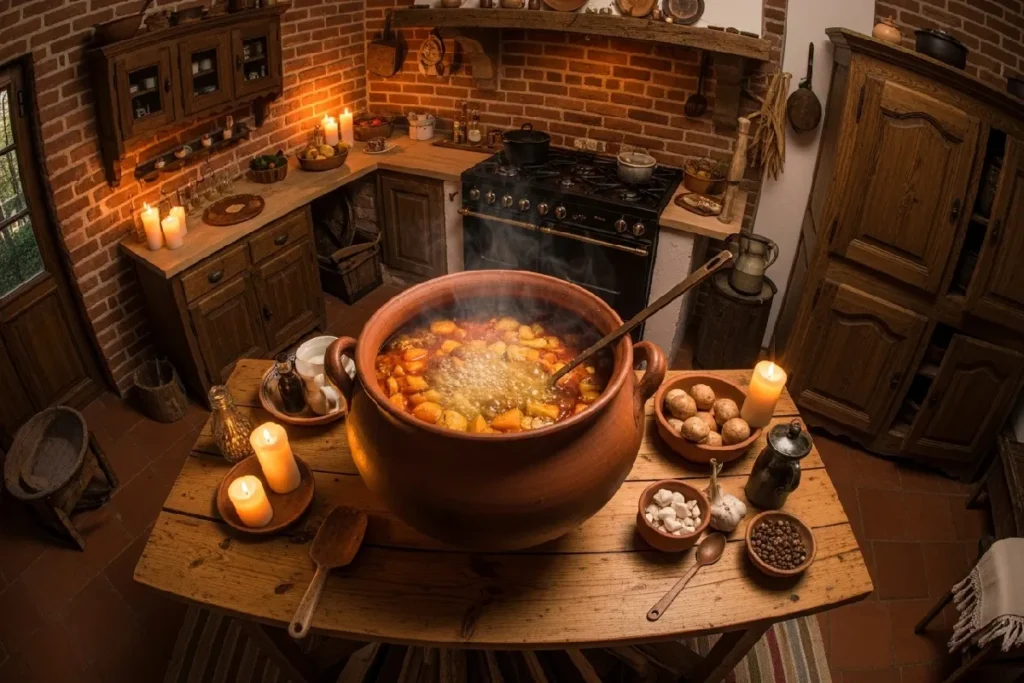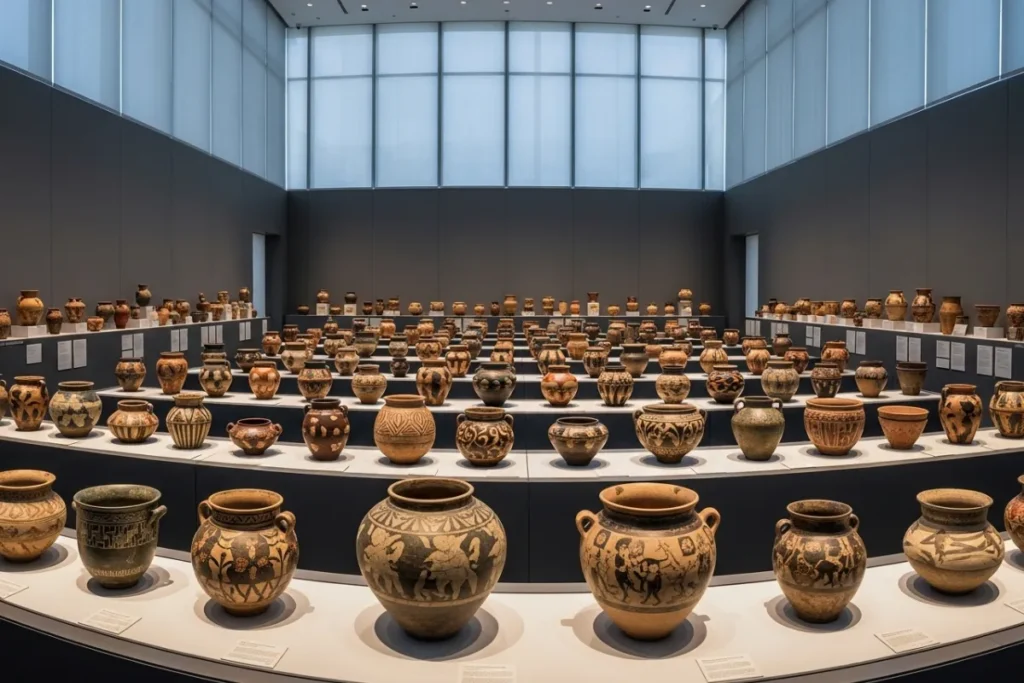Explore the profound cultural significance of cooking pots across various societies. This blog post delves into the historical evolution, communal culinary practices, and the enduring legacy of these vessels that foster social bonds and preserve cultural food heritage. Discover how cooking pots transcend their utilitarian purpose, becoming symbols of identity, tradition, and shared experiences in both historical and modern contexts.
Table of Contents
Introduction to the Cultural Significance of Cooking Pots
Cooking pots have historically occupied a central place within various cultures, serving as more than mere kitchen tools. These communal cooking pots are pivotal symbols intertwined with tradition, community, and individual identity. Across the globe, from the clay pots of indigenous tribes to intricately designed ceramic dishes in Mediterranean households, the act of cooking has always been a communal activity, promoting social interactions and fostering a sense of belonging. This signifies the vital role these vessels play in contributing to a community’s cultural food heritage.
The traditional kitchenware history indicates that cooking pots were often crafted with the intention of unifying families and communities, thereby reinforcing social bonds. It was not uncommon for families to come together to prepare meals in these pots, sharing both the culinary responsibility and the resulting sustenance. This shared experience reflects the deeper symbolism of food and togetherness, which extends to festivals, celebrations, and everyday gatherings across various societies. In this way, cooking pots become crucial in constructing and expressing social identity.
Moreover, communal cooking pots often embody regional craftsmanship, integrating local materials and techniques, which further highlights the cultural significance activities surrounding their production and usage. These pots frequently transcend their utilitarian origins, encapsulating stories of tradition and memory. They serve as tangible connections to ancestors and historical practices, enriching the cultural narrative of a community. By examining these elements, we can appreciate how cooking pots bridge generations, facilitating the ongoing transmission of cultural values and culinary practices. Ultimately, they are not simply tools but are deeply embedded in the fabric of our collective identity, as they symbolize nourishment and the human experience of connection through food.
Historical Evolution of Cooking Pots
The evolution of cooking pots is a fascinating journey that reflects broader societal transformations, technological advancements, and the essence of cultural food heritage. Early communal cooking pots, often constructed from clay or stone, served as essential tools for preparing sustenance in various civilizations. These vessels catered to the communal needs of tribal societies, symbolizing food and togetherness through shared culinary experiences.
As time progressed, the materials employed in crafting these traditional kitchenware pieces evolved significantly. The introduction of metals, particularly bronze and iron, marked a notable shift in cooking pot design around the Iron Age. These metal pots boasted durability and improved heating properties, enabling more efficient cooking methods. The advent of ceramic glazes further refined the utility of cooking pots, not only enhancing their aesthetics but also making them easier to clean, thus influencing social identity through cooking practices.
With the Industrial Revolution, the mass production of kitchenware became widespread, leading to a diversification of designs and materials. This era saw the introduction of enameled cast iron and stainless steel, which, while modernizing culinary techniques, also brought about a sense of nostalgia for the traditional clay pots that had been central to numerous cultural identities. As people migrated and cultures mingled, the significance of communal cooking pots endured, adapting to new culinary practices while retaining their status as symbols of togetherness.
In contemporary society, the historical trajectory of cooking pots continues to influence both kitchen practices and social dynamics. Modern cooking vessels, while incorporating advanced materials and technologies, still echo the age-old symbolism of food and community bonding. Ultimately, the historical evolution of cooking pots showcases a remarkable narrative of resilience and adaptability, connecting past with present, while solidifying their integral role in enriching our communal experiences around food.

Culinary Practices and Community Identity
Throughout history, culinary practices have served as a vital link connecting individuals within a community, transcending geographical and cultural boundaries. Central to these practices are communal cooking pots, which play a significant role in shaping social interactions and reinforcing cultural food heritage. In many cultures, the act of cooking in shared pots symbolizes food and togetherness, providing a relaxed atmosphere where individuals gather to prepare meals collectively. This shared experience fosters bonds among participants, empowering them to express their identity and heritage through traditional cuisine.
For instance, in various African communities, large communal cooking pots are commonly employed to prepare dishes that are meant to be enjoyed by extended families and neighbors. This practice not only emphasizes the importance of the meal itself but also highlights the social identity associated with sharing food. Community members come together, each contributing their unique recipes and culinary skills, which enriches the overall experience of dining together. The communal pot becomes a powerful symbol of unity, tradition, and collaboration as it brings forth participatory cooking—an exercise in sharing not only the meal but also one’s cultural identity.
Similarly, in many Latin American households, the tradition of “cocinar en familia” involves family members gathering around a single pot to engage in the culinary process. This practice strengthens familial ties and reinforces a collective sense of belonging, as individuals share stories and traditions while cooking. The very act of passing down recipes from generation to generation embodies the rich tapestry of traditional kitchenware history, equivalent to a living archive of a community’s cultural heritage.
Furthermore, the symbolism behind shared cooking experiences stretches beyond food preparation; it represents a continuation of cultural narratives and the social fabric that binds communities together. In conclusion, communal cooking pots not only serve as practical kitchenware but also encapsulate the essence of community identity, illustrating the intertwining of culinary practices, social identity, and cultural memory.
Symbolism and Rituals Surrounding Cooking Pots
Across diverse cultures, communal cooking pots embody rich symbolic meanings and are integral to various rituals. These vessels transcend mere functionality, becoming objects deeply intertwined with cultural identity and social practices. Cooking pots often serve as a focal point during family gatherings and community celebrations, symbolizing togetherness and unity. In many traditions, the act of cooking in communal pots is associated with values of sharing and inclusiveness, reinforcing social bonds among participants.
In several cultures, cooking pots are also central to rites of passage, marking significant life events such as weddings, births, and other communal milestones. For instance, in some African and Asian societies, the gifting of a family pot to newlyweds symbolizes the couple’s commitment to nurturing and sustaining their community through shared meals. This illustrates how traditional kitchenware is not only essential in food preparation but also plays a pivotal role in shaping social identity and community cohesion.
Moreover, the rituals associated with cooking pots often reflect the cultural food heritage of a people. In many Mediterranean cultures, for example, specific dishes are prepared in designated pots passed down through generations, signifying respect for ancestors and tradition. These culinary practices serve as oral histories executed through food, bridging the gap between past and future while maintaining cultural narratives. The symbolism of these pots extends beyond their physical presence to embody the essence of food and togetherness, serving as a reminder of the shared human experience of gathering around a meal.
Thus, cooking pots are much more than kitchen tools; they represent the cultural fabric that weaves individuals and communities together, symbolizing the interconnectedness of heritage, identity, and social practices.

Cooking Pots in Modern Society: A Reflection of Identity
In contemporary society, the significance of communal cooking pots extends beyond mere functionality; they symbolize personal and collective identities within multicultural settings. As global migration increases, kitchens around the world have become melting pots of diverse culinary traditions. This has led to the emergence of unique dishes that blend various cultural food heritages, bringing together flavors, techniques, and ingredients that reflect the modern world’s dynamic social fabric.
Cooking pots serve as vital tools for promoting togetherness and cohesion in many households. The act of preparing meals in communal cooking pots fosters an environment of sharing and collaboration, allowing families and friends to bond over food. This symbolism of food and togetherness illustrates the deep connections shared within communities, showcasing how shared culinary practices can reinforce social identity. The act of gathering around a pot of stew or rice, for example, can be a powerful testament to one’s cultural roots and traditions.
Furthermore, traditional kitchenware history reveals how certain pots have transcended their culinary roles to become cultural icons. For instance, clay pots from one region and cast iron skillets from another not only represent the cooking methods of their respective communities but also reflect the lives of those who use them. In today’s globalized society, individuals are increasingly acquiring diverse kitchenware that represents various cultures, thereby enriching their own cooking practices and enhancing their culinary worldview.
Ultimately, the fusion of techniques and culinary heritage served in these communal cooking pots showcases the blending of identities in modern kitchens. As people continue to explore global flavors, they not only nourish their bodies but also engage with the cultural narratives embedded in each dish. This blending of traditions through cooking pots contributes significantly to shaping our collective identity in an increasingly interconnected world, emphasizing the role of food as a universal connector.
Innovations in Cooking Pots and Their Impact on Cuisine
The evolution of cooking pots in recent years showcases an impressive blend of tradition and innovation. As culinary practices continue to advance, innovations such as non-stick coatings, pressure cooking, and smart kitchen technology have significantly transformed cooking methods and cultural engagement in the kitchen. The rise of non-stick pots has made food preparation simpler and cleaner, promoting exploration within various culinary traditions. These pots facilitate the preparation of dishes that reflect diverse cultural food heritage, enabling cooks to experiment with flavors and techniques without the concern of food sticking and burning.
Pressure cooking has also emerged as a revolutionary innovation, drastically reducing cooking time while enhancing the flavors within the food. This method has become increasingly popular, allowing for the preparation of complex dishes that previously required hours of cooking. The pressure cooker not only preserves the nutritional integrity of the ingredients but also aligns with contemporary demands for efficiency in meal preparation. As a result, these cooking pots foster communal cooking experiences, accommodating larger gatherings and celebrations, ultimately reinforcing the concept of food and togetherness symbolism.
The integration of smart technology into kitchenware is yet another noteworthy advancement. Smart pots equipped with sensors and connectivity features enable users to remotely monitor and control cooking processes. This cutting-edge approach to traditional kitchenware history represents a fusion of modern convenience with age-old cooking principles. Furthermore, it encourages a cultural exchange among users who can share recipes and cooking techniques digitally, thus redefining collective culinary identities across the globe. The innovations in communal cooking pots not only streamline food preparation but also strengthen social identity while honoring diverse culinary traditions. In conclusion, such advancements signify a sensitivity to both practicality and the profound communal aspects of cooking, shaping our collective identity in the kitchen.

Case Studies: Cooking Pots as Cultural Artifacts
Cooking pots serve not only practical purposes in the kitchen but also carry profound cultural significance across various societies. To better understand their impact, we can examine a few specific types of cooking pots that reflect diverse cultural food heritage and social identities.
One notable example is the clay pot, which has been an essential cooking tool in many Indigenous cultures. Its porous nature allows for even heat distribution and moisture retention, making it ideal for slow-cooked meals. In regions such as Mexico, the use of clay pots—known as ‘olla’—is deeply embedded in daily life and rituals, representing a connection to ancestral cooking methods. In this context, communal cooking pots embody not just utility but serve as symbols of food and togetherness, creating communal bonds during family gatherings and celebrations.
Another significant type of pot is the wok, which has its roots in Chinese culinary practices. The design of the wok is crucial for generating high heat and facilitating stir-frying, which is a cornerstone of Chinese cuisine. The communal aspect of wok cooking promotes togetherness as meals are often prepared in front of guests, allowing for interaction and engagement. This type of traditional kitchenware history highlights how cooking methodologies are linked intimately with cultural expressions and social identity, showcasing the dynamic interplay between food and rituals.
Lastly, the Dutch oven stands out as a versatile cooking pot with deep connections to Western European heritage. Traditionally made from cast iron, Dutch ovens are known for their durability and excellent heat retention. They are ideal for both cooking and serving, often becoming central to family meals. This cooking pot symbolizes home-cooked meals and familial ties, further emphasizing the importance of shared eating experiences.
These case studies reveal that cooking pots are much more than mere kitchen tools; they are communal cooking pots that encapsulate cultural narratives and collective identities, solidifying the role of food in fostering relationships and traditions across generations.
Challenges and Changes in Culinary Traditions
The evolution of culinary traditions is often a reflection of broader societal changes, particularly in the context of globalization and modernization. Traditional practices concerning communal cooking pots, which once served as symbols of food and togetherness, now face numerous challenges. As the world becomes increasingly interconnected, many cultures experience the dilution of their culinary heritage. The emergence of fast food chains and ready-to-eat meals has led to a decline in the preparation of traditional dishes that once brought families and communities together around a single pot.
These shifts in eating habits can significantly impact social identity, with younger generations gravitating towards modern convenience rather than valuing the time-honored practices enshrined in their cultural food heritage. Moreover, the prosperity of the food industry, focused on efficiency and mass production, often undermines the significance of traditional kitchenware history. As communal cooking pots are replaced by single-serving devices, the fundamental act of cooking alongside one another diminishes, threatening the very fabric of togetherness that these culinary traditions once celebrated.
However, many communities strive to preserve their cooking customs amid these challenges. Various initiatives, such as culinary festivals, workshops, and educational programs, have been launched to promote traditional cooking methods and the use of communal pots. These efforts aim not just to retain the history of cooking practices but to reinforce the social bonds that these activities foster. By emphasizing the communal aspect of cooking and the symbolism of food as an identity marker, communities can combat the looming shadows of globalization and modern consumerism. The resilience of cultural food heritage illustrates the potential for communal cooking pots to remain relevant in contemporary society while sustaining their historical significance.
| Aspect | Description |
|---|---|
| Historical Role | Communal cooking pots symbolized unity, shared meals, and cultural identity within communities. |
| Modern Challenges | Globalization, modernization, fast food, and convenience culture contribute to the decline of traditional cooking practices and communal meal preparation. |
| Impact on Social Identity | Younger generations tend to prioritize speed and convenience, weakening intergenerational bonds rooted in shared culinary experiences. |
| Food Industry Influence | Mass production and efficiency overshadow the cultural and emotional value of traditional cooking tools and methods. |
| Cultural Response & Preservation | Communities are fighting back with cooking festivals, workshops, and education to promote traditional practices and communal cooking values. |
| Contemporary Relevance | Despite modern pressures, communal cooking pots still hold potential as tools for sustaining cultural identity and social cohesion. |
Conclusion: The Enduring Legacy of Cooking Pots
Throughout history, communal cooking pots have served not merely as kitchenware but as significant symbols encapsulating cultural food heritage. These vessels have fostered communal gatherings and culinary traditions, playing a pivotal role in sharing meals that bring people together. In various cultures, the act of cooking in shared pots reinforces social identities, transforming routine food preparation into meaningful rituals reflecting community bonds and individual ties to heritage. (Read an illustrative account of how traditional clay pots retained cultural knowledge in Arctic communities).
The evolution of traditional kitchenware reflects broader societal changes, yet the quintessential role of cooking pots in nurturing relationships remains unchanged. With their ability to facilitate food and togetherness, these pots illustrate how the rituals of cooking connect generations, bridging past and present. Each pot tells a story; whether it’s the recipe passed down through families or the communal experiences crafted around it, these artifacts embody the social fabric that holds communities together.
In an increasingly globalized world, where culinary practices often blend and intermingle, the reverence for traditional cooking pots and their historical significance remains poignant. Recognizing that these kitchen essentials are steeped in tradition can encourage individuals to explore their own roots. As we continue to stir, simmer, and serve, let’s take a moment to appreciate the collective journey these pots have embarked upon, connecting us through time and tradition.
In conclusion, the enduring legacy of cooking pots extends beyond their utilitarian function. They represent a rich tapestry of social identity and cultural narratives. We are challenged to consider the significance of our own cooking pots in our kitchens, inviting us to uncover the stories they hold and to cherish the connections they continue to foster in our lives.








